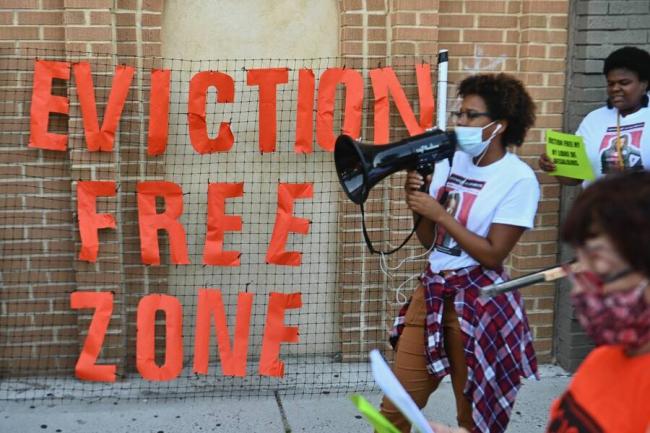The Biden administration announced a new, temporary eviction moratorium on Tuesday afternoon — a direct response to pressure from Rep. Cori Bush (D‑Mo.), who camped out on the steps of the Capitol to demand relief for renters. While tenant organizers breathed a sigh of relief at the development, they also criticized the patchwork and narrow nature of the Centers for Disease Control and Prevention (CDC) order, which applies only to counties that meet a certain threshold for Covid-19 outbreaks.
Tenant advocates have been sounding the alarm about an “eviction cliff” that loomed with the end of the old CDC eviction moratorium on August 1, and they say Biden’s new extension does not address the full scope of the crisis. Given that more than 15 million people are living in households behind on rental payments, according to the Aspen Institute, the eviction moratorium is clearly a stopgap where much more systemic solutions are necessary. Amid this stark political reality, local and statewide efforts around the country point to other models that treat the housing issues magnified by the pandemic in a more systemic fashion, hoping to change landlord-tenant dynamics for the better.
It’s a tall order for organizers, advocates and tenants who are already scrambling to meet the needs of those being removed from their homes. These groups are attempting to change public perception of a renter’s right to secure housing. With millions on the brink of losing their homes, and with cities like Los Angeles passing draconian new measures to further criminalize homelessness, the task of enacting housing as a human right has never been more urgent.
Here’s how some tenant advocates are meeting the urgency of the moment by organizing locally, in order to change the conversation nationally.
Just Cause for Eviction passes in Albany
One policy being considered in numerous municipalities to ensure the longer-term stability of rental housing is Just Cause for Eviction, which would prevent no-fault tenant displacement. (Disclosure: the author of this piece is an organizer with a coalition in Chicago working on a Just Cause ordinance.) Just Cause (or Good Cause) for Eviction states that landlords must provide a clear reason for an eviction. While traditional tenant-fault reasons like nonpayment of rent remain, Just Cause would slow the use of non-tenant-fault evictions, which are often undertaken when a landlord wants to flip the property for more money or remove a tenant who has complained about unsafe living conditions. It’s a common-sense approach that goes beyond measures like rental assistance or eviction moratoria, recognizing that evictions will remain a concern long after the pandemic.
The most recent locale to pass Good Cause is Albany, New York, which enacted the bill in July. For Alfredo Balarin, lead sponsor of the bill, Just Cause approaches the deeper causes of housing instability left untouched by other measures.
“Just Cause is looking at long-term housing stability issues, not just the short-term immediate relief that’s needed,” Balarin says. “[It’s] looking to make sure that you protect good tenants who are doing everything right and have a right to be able to live in stable, quality housing.”
Before the pandemic, Just Cause was already in place in four states (California, New Hampshire, New Jersey and Oregon), as well as in more than 20 cities. Several other cities in New York are currently considering the legislation after it was blocked as a statewide bill, while the state of Washington adopted Just Cause this May.
Pushing politicians to the left
While tenants and their supporters have fought for visionary policies that go beyond the status quo, another significant part of the battle remains focused on improving policies that are being put forth by political leaders. That’s been true in California, where Governor Gavin Newsom signed a bill in late June to make $5.2 billion available to pay all outstanding rent for California tenants, and up to three months of future rent, by far the most money invested into rent relief by any individual state. While far more universal than some other programs, the legislation is plagued by some of the same problems that are playing out at the federal level, with only $61.6 million distributed by the state as of late June.
According to Shanti Singh, communications director for Tenants Together, a group that supports tenant organizing around the state, some aspects of the legislation create more ambiguity for renters. The state’s eviction moratorium has been extended until the beginning of October, at which point municipalities are preempted from passing their own additional protections against eviction for nonpayment of rent until April 2022. Instead, tenants are only legally protected from eviction if they face the case in eviction court and have completed an application for financial assistance. Given that only a small percentage of tenants have legal representation in court, and many undocumented people will “self evict” due to fear of deportation, it’s an approach that leaves plenty to be desired.
Still, Singh argues that more radical demands like calls to cancel people’s rents and mortgages outright, as advocated by groups like Right to the City, a nationwide alliance of housing organizations, have improved the bill that was passed. For example, Singh notes that under the final version of the bill that was passed, both tenants and landlords can apply for up to 100% of back rent owed; earlier in negotiations landlords would have received 80% paid by the state if they waived the other 20%, while tenants seeking assistance against landlords who refused to comply could only receive 25%. That shift will help thousands more families wipe their rental debt clean, a much-needed shift won through community pressure, even as advocates are still frustrated that the bill serves as a massive handouts to landlords, in contrast to the rent and mortgage cancellation approach.
“I think if we hadn’t been out front making the demands to cancel rent and to cancel mortgages, from the beginning, I don’t think we would have gotten to the point where the governor felt compelled to say that tenants [could] get 100% of their money back,” Singh says. “That pressure and that heat was productive.”
Fighting against means testing
The ineffective distribution of federal rent relief funds has been one of the biggest flaws of the federal approach: While $46.5 billion was allocated through January’s Emergency Relocation Assistance program, just $3 billion, or about 7%, reached vulnerable renters by the end of June, according to the Treasury Department.
Cutting through this gridlock and ensuring that government benefits reach people with a minimum of regulatory barriers is one of the key goals embraced by activists. Santa Fe-based Chainbreaker Collective expedited the distribution of emergency housing funds as a political priority, as they worked with local officials to minimize red tape and get funds in people’s hands, no questions asked.
Last fall, Chainbreaker partnered with Somos Un Pueblo Unido, a statewide immigrant worker advocacy organization, and city officials to target families who had not received stimulus money — primarily undocumented families. Chainbreaker managed to get 167 families $3,000 in unrestricted funds, available as a direct deposit or as a prepaid debit card for those without access to formal banking.
For Chainbreaker community organizer Cathy Garcia, getting people funds with no strings attached has been the biggest shortcoming of many of the federal and state approaches to financial assistance for renters.
“We’re putting all this money on this really high shelf, and then being like, “Yeah, I’m not surprised they can’t reach it… so I guess we’ll put it back into the general fund,’” Garcia says.
Other groups have embraced the model of direct assistance with minimal red tape, recognizing that impacted communities can define their own needs. Another powerful example of the rapid distribution of financial assistance came last summer in the Twin Cities, as Nexus Community Partners, which works to support cooperative economic principles, distributed more than $7 million through its Transformative Black-Led Movement Fund, primarily to groups without formal legal status. Given the bureaucratic nightmares that have kept millions from receiving government funds they were legally entitled to, these initiatives are vital to getting working-class people the resources they deserve.
Decommodifying housing through Community Land Trusts
Beyond administering direct assistance, Chainbreaker has also fought to create what would become one of the nation’s largest community land trusts. After years of trying to sell a 64-acre parcel for development, the city of Santa Fe’s chosen contractor asked the city in January to terminate the contract. Even before then, the city began using the site’s former dormitories for emergency housing during the pandemic, a commitment that the city recently reaffirmed until July 2022. That toehold has allowed Chainbreaker to make the case for the site to come under full community control, expanding its reach to also house mobile home users who are being displaced from trailer parks elsewhere in the city.
For Garcia, it’s exactly the kind of decision that would set the tone for the future of Santa Fe. The midtown site is also where the city has its highest eviction rates, and it divides some of the richest and poorest parts of town. Making a commitment for permanent affordable housing in a city whose median home value recently climbed past $600,000 could set the tone for a more human-centered housing policy.
As housing becomes increasingly unaffordable everywhere in the United States, prices driven upwards by corporate landlords who have bought thousands of single-family homes from foreclosure and now rent them at inflated rates, the growth of community land trusts is a vital reminder that housing should not be commoditized as it is today. As a recent Shelterforce article argued, community land trusts have “become one of the most common policy answers to ‘how will we [insert revitalization plan here] without causing displacement?’” and the number of community land trusts nationwide has grown from just 162 in 2006 to 289 today. In Santa Fe, Garcia sees the fate of this project as one that will forever define the city’s future, and whether it — like the rest of the country — can change course and begin to mend the harm caused by decades of growing housing precarity. It’s a vision that carries far beyond the immediate wrangling around the CDC eviction moratorium, knowing that housing injustice has been an issue long before the pandemic began.
“Midtown campus is literally right on the divide between the haves and the have nots,” Garcia says. “How it gets developed is absolutely going to set up the history of the city for forever into the future.”

